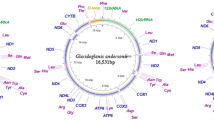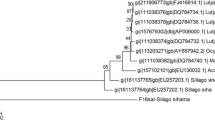Abstract
Mitochondrial DNA (mtDNA) atCo-1 gene region was sequenced for 7 scorpion fish species (in total, 16 sequences of at least 552 bp) from the Far East of Russia and compared with 15 other sequences of Scorpaeniformes comprising altogether 29 scorpion-like fish sequences and two outgroup sequences (Cypriniformes). The analysis of the protein-codingCo-1 gene revealed statistically substantiated bias in the (T+C) ∶ (A+G) content, proving basic findings. The average scores ofp-distances for different scales of the evolutionary history atCo-1 gene revealed a clear pattern of increased nucleotide diversity at four different levels: (1) intraspecies, (2) intragenus, (3) intrafamily, and (4) intraorder. The scores of averagep-distances for the compared fish groups were: (1) 1.00±0.20%, (2) 3.80±0.20%, (3) 12.40±1.20%, and (4) 18.00±0.38%, respectively (mean±SE). These data support the concept that speciation in the order Scorpaeniformes, in most cases, follows a geographic mode through accumulation of numerous small genetic changes over a long period of time. However, intraspecies diversity was surprisingly high among scorpionfish. Phylogenetic trees for 29 sequences of scorpionfish and 2 other fishes belonging to ray-finned fishes (Actinopterigii) were developed usingCo-1 gene and four different analytical approaches: Bayesian (BA), maximum likelihood (ML), neighbour-joining (NJ), and maximum parsimony (MP). The analysis revealed a monophyletic origin for the representatives of Cottidae, which is the principal scorpionfish family investigated (100, 96, 98% support level in our BA, MP, and NJ analyses). Similarly, the monophyletic origin of up to the three compared scorpion-like fish genera was supported by molecular phylogenetic data. Species identification on individual basis (barcoding tagging) was high. A few taxonomic complications arose during the analysis and they are discussed here in.
Similar content being viewed by others
References
Avise JC (2001)Phylogeography. The History and Formation of Species. Harvard University Press, Cambridge, MA.
Ayala FJ, Tracey ML, Hedgecock D andRichmond RC (1974) Genetic differentiation during the speciation process in Drosophila. Evolution. 28: 576–592.
Bolin RL (1944)A review of marine Cottid fishes of California. Natural history museum of Stanford University, Stanford University, California.
Bolin RL (1947)The evolution of marine Cottidae of California with a discussion of the genus as systematic category. Stanford University, California.
Bush GL (1975) Modes of animal speciation. Ann. Rev. Ecol. Syst. 6: 339–364.
Dobzhansky Th (1955)Evolution, Genetics And Man. John Wiley & Sons Inc. NY, Chapman & Hall, Limited-London, 398 p.
Fedorov VV (1986) Cottidae. InFishes of the Northeastern Atlantic and the Mediterranean, PJP Whitehead, M-L Bavchot, J-C Hvreau, J Nislsen and E Tortonese, eds., Vol. 3, UNESCO, Paris, pp. 1243–1260
Felsenstein J (2004)Inferring phylogenies. Sinauer Associates Inc. Sanderland, Massachusetts, 664 pp.
Hall B (2001)Phylogenetic trees made easy. A howto manual for molecular biologists. Sinauer Assoc. Inc. Publishers, Sunderland, Massachusetts 01375.
Harrison RG (1998) Linking evolutionary pattern and process: The relevance of species concepts for the study of speciation. InEndless Forms: Species and speciation, DJ Howard SH Berlocher, eds., Oxford Univ. Press, Oxford, NY, pp. 19–31.
Hebert PD, Stoeckle MY, Zemlak TS andFrancis CM (2004) Identification of birds through DNA barcodes. PLoS Biology 2: e312.
Hillis DM (1998) Taxonomic sampling, phylogenetic accuracy, and investigator bias. Systematic Biology 47: 3–8.
Hillis DM, Moritz C andMable B (1996)Molecular Systematics.. Sinauer. Assoc. Inc.,Sunderland, Massachusetts (01375-0407, USA) pp. 407-514.
Hulsenbeck JP andRondquist F (2001) Mr. BAYES: Bayesian inference of phylogeny. Bioinformatics. 17: 754–755.
Jackson KL (2003)Contributions to the systematics of Cottoid fishes (Teleostei: Scorpaeniformes). Department of Biological Sciences, University of Alberta, 13 pp. 181 leaves.
Johns GC andAvise JC (1998) A Comparative summary of genetic distances in the vertebrates from the mitochondrial cytochrome b gene. Molecular Biology and Evolution 15: 1481–1490.
Kartavtsev YP (1975) A comparative electrophoretic analysis of haemoglobins, water soluble muscle and crystalline lens’ proteins of five sculpin species of Cottidae family. Russian Journal of Marine Biology 2: 31–38.
Kartavtsev YP (2005)Molecular evolution and population genetics. Far Eastern State Univ. Press., Vladivostok, 234 p.
Kartavtsev YPh, Park T-J, Lee J-S, Vinnikov KA, Ivankov VN, Sharina SN andPonomarev AS (2008) Phylogenetic inferences introduced on cytochrome b (Cyt-b) gene sequences data for six flatfish species (Pisces, Pleuronectidae) and species synonymy among representatives of generaPseudopleuronectes andHippoglossoides from far eastern. Russian J. Genetics 44: 451–458.
Kartavtsev YP andLee J-S (2006) Analysis of nucleotide diversity at genesCyt-b andCo-1 on population, species, and genera levels. Applicability of DNA and allozyme data in the genetics of speciation. Russian J. Genetics 42: 437–461.
Kartavtsev YP, Lee Y-M, Jung S-O, Byeon H-K andLee J-S (2007a) Complete mitochondrial genome in the bullhead torrent catfish,Liobagrus obesus (Siluriformes, Amblycipididae) and phylogenetic considerations. Gene 396: 13–27.
Kartavtsev YP, Park T-J, Vinnikov KA, Ivankov VN, Sharina SN andLee J-S (2007b) Cytochromeb (Cyt-b) gene sequences analysis in six flatfish species (Pisces, Pleuronectidae) with phylogenetic and taxonomic insights. Journal Marine Biology 152: 757–773.
Kartavtsev YP, Sviridov VV, Sasaki T andHanzawa N (2002) Genetic divergence of far eastern dace belonging to the genusTribolodon (Pisces, Cyprinidae) and closely related taxa: some insights in taxonomy and speciation. Genetica 38: 1518–1531 (In Russian, translated in English).
Kim I-Ch andLee J-S (2004) The complete mitochondrial genome of the rockfish Srbastes schlegeli (Scorpaeniformes, Scorpaenidae). Mol. Cells 17: 322–328.
Kim I-C, Kweon H-S, Kim Y-J, Kim C-B, Gye M-C, Lee W-O, Lee Y-S andLee J-S (2004) The complete mitochondrial genome of the javeline gobyAcanthogobius hasta (Perciformes, Gobiidae) and phylogenetic considerations. Gene 336: 147–153.
King M (1993)Species Evolution: the role of chromosome Change. Cambridge: Cambridge University Press, 336 pp.
Kontula T, Kirilchik SV andVainola R (2003) Endemic diversification of the momophyletic cottoid fish species flock in Lake Baikal explored with mtDNA sequencing. Molecular Phylogenetics and Evolution 27: 143–155.
Kontula T andVainola R (2003) Relationships of Palearctic and nearctic ‘glacial relict’Myoxocephalus sculpins from mitochondrial DNA data. Molecular Ecology 12: 3179–3184.
Kumar S, Tamura K and Nei M (1993) MEGA: Molecular evolutionary genetics analysis (with a 130-page printed manual). University Park: Pennsilvania State Univ. MEGA3. Web-base \-version, 2005 update.
Lee J-S (2000) The internally self-fertilized hermaphroditic teleostRivulus marmoratus (Cyprinodontiformes, Rivulidae) β-actin gene: Amplification and sequence analysis with conserved primers. Marine Biotechnology 2: 161–166.
Mayr E (1968)Zoological species and evolution. Mir Publishers, Moscow, 398 p. (Russian ed).
Mayr E (1982) Process of speciation in animals. InMechanisms of speciation. Ed. C. Barigozzi. Alan R. Liss, NY pp. 1–20.
Miya M, Kawaguchi A andNishida M (2001) Mitogenomic exploration of higher teleostean phylogenies: a case study for moderate-scale evolutionary genomics with 38 newly determined complete mitochondrial DNA sequences. Molecular Biology and Evolution 18: 1993–2009.
Miya M, Takeshima H, Endo H, Ishiguro NB, Inoue JG, Mukai T, Satoh TP, Yamaguchi M, Kawaguchi A, Mabuchi K, Shirai SM andNishida M (2003) Major patterns of higher teleostean phylogenies: a new perspective based on 100 complete mitochondrial DNA sequences. Molecular Phylogenetics and Evolution 1: 121–138.
Nailor GJ, Collins TM andBrown WM (1996) Hydrophobicity and phylogeny. Nature 373: 565–566.
Nei M (1987)Molecular evolutionary genetics. Columbia Univ. Press, NY, 512 pp.
Nei M andKumar S (2000)Molecular evolution and Phylogenetics. Oxford Univ. Press, NY 333 pp.
Nelson JS (1994)Fishes of the world. John Wiley and Sons Inc., Third edition. New York, 600 p.
Nohara M, Nishida M, Miya M andNishikawa T (2005) Evolution of the mitochondrial genome in cephalochordata as inferred from complete nucleotide sequences from two epigonichthys species. Journal of Molecular Evolution 60: 526–537.
Page RDM (1996) TREEVIEW: An application to display phylogenetic trees on personal computers. Comparative and Applied Bioscience 12: 357–358.
Paxton JR, Hoese DF, Allen GR andHanley JE (1989)Pisces. Petromyzontidae to Carangidae. Zoological Catalogue of Australia, Vol. 7, Australian Government Publishing Service, Canberra, 665 p.
Pietsch TW (1993) Systematics and distribution of cottid fishes of the genus Triglops Reinhardt (Teleostei: Scorpaeniformes). Zoological Journal of Linnean Society 109: 335–393.
Posada D andGrandal KA (1998) MODELTEST: testing the model DNA substitution. Bioinformatics 14: 817–818.
Radchenko OA, Chereshnev IA, Nazarkin MV, Petrovskaya AV andChegodaeva EA (2008) Restriction variability of cytochrome b gene of mitochondrial DNA in some taxa of eel-pout of the family Zoarcidae (Pisces, Perciformes) in north part of the Sea of Okhotsk. Russian J. Genetics 44: 94–100.
Ramon ML andKnope ML (2008) Molecular support for marine sculpin (Cottidae; Oligocottinae) diversification during the transition from subtidal to intertidal habitat in the Northeastern Pacific Ocean. Molecular Phylogenetics and Evolution 46: 475–483.
Ronquist F andHuelsenbeck JP (2003) Mr.BAYES 3: Bayesian phylogenetic inference under mixed models. Bioinformatics 19: 1572–1574.
Ryazanova IN, Borisenko SA andFrolov SV (2008) Comparative analysis of the karyotype of the sculpinMyoxocephalus ochotensis (Pisces, Cottidae) from Odyan Bay, Sea of Okhotsk. Biologiya Morya, Vladivostok 33: 225–228.
Shedko SV andMiroshnichenko IL (2007) Phylogenetic relationships of sculpinCottus volki Taranetz, 1993 (Scorpaeniformes, Cottidae). Journal of Ichtiology 47: 21–25.
Simmons MP andMiya M (2004) Efficiently resolving the basal clades of a phylogenetic tree using Bayesian and parsimony approaches: a case study using mitogenomic data from 100 higher teleosts fishes. Molecular Phylogenetics and Evolution 31: 351–362.
Simpson GG (1961)Principles of Animal Taxonomy. The Species and Lower Categories. Columbia Univ. Press, NY.
Swofford DL (2002) PAUP*: Phylogenetic analysis using parsimony, version 4.10. Sinauer Associates, Sunderland, MA.
Tamura K, Dudley J, Nei M and Kumar S (2007) MEGA4: Molecular Evolutionary Genetics Analysis (MEGA) software version 4.0. Molecular Biology and Evolution 10.1093/molbev/msm092.
Templeton AR (1981) Mechanisms of speciation-population genetic approach. Ann. Rev. Ecol. Syst. 12: 23–48.
Thompson JD, Higgins DG andGibson TJ (1994) Clustal W: Improving the sensitivity of progressive multiple sequence alignment through sequence weighting, position, specific gap penalties, and weight matrix choice. Nucleic Acids Research 22: 4673–4680.
Wallace DC (1992) Diseases of the mitochondrial-DNA. Annual Review of Biochemistry 61: 1175–1212.
Ward RD andHolmes BH (2007) An analysis of nucleotide and amino acid variability in the barcode region of cytochrome c oxidase I (cox1) in fishes. Mol. Ecol. Notes 7: 899–907.
Ward RD, Zemlak TS, Innes BH, Last PA andHebert PDN (2005) DNA barcoding Australia fish species. Philosophical Transactions of the Royal Society of London B 360: 1847–1857.
Wilcox TP, Garcia de Leon FJ, Hendrickson DA andHillis DM (2004) Convergence among cave catfishes: long-branch attraction and a Bayesian relative rates test. Molecular Phylogenetics and Evolution 31: 1101–1113.
Yabe M (1985) Comparative osteology and myology of superfamily Cottoidea (Pisces: Scorpaeniformes), and its phylogenetic classification. Faculty of Fishes, Hokkaido University, Hakodate, Japan.
Author information
Authors and Affiliations
Corresponding author
Rights and permissions
About this article
Cite this article
Kartavtsev, Y.P., Sharina, S.N., Goto, T. et al. Sequence diversity at cytochrome oxidase 1 (Co-1) gene among sculpins (Scorpaeniformes, Cottidae) and some other scorpionfish of Russia Far East with phylogenetic and taxonomic insights. Genes & Genomics 31, 183–197 (2009). https://doi.org/10.1007/BF03191151
Received:
Accepted:
Issue Date:
DOI: https://doi.org/10.1007/BF03191151




